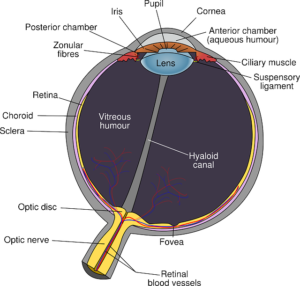The doctor’s official diagnosis was “big honkin’ cataract”. The doctor assured Tom that it had nothing to do with the nerve damage caused by his lung tumor. The blurry vision had shown up around the same time as his other diagnosis, so we weren’t sure, the oncologist had referred Tom to this eye doctor and he was recommending surgery.
In fact, there were cataracts in both his eyes but the right one gave him the most trouble. He struggled with blurry vision, trouble seeing in bright light and occasional challenges with depth perception. A second opinion confirmed the diagnosis. Big honkin’ cataract.

A cataract is a clouding of the lens in the eye that affects vision. It is the most common cause of vision loss in people over 40 and causes more vision problems globally than any other eye condition or disease. According to the National Eye Institute, more than half of all Americans will either have a cataract or have had cataract surgery by age 80.
The lens is a clear part of the eye that works like a camera lens to focus light on the retina. The retina is light-sensitive tissue at the back of the eye. The lens is behind the iris and the pupil and must be clear for the retina to receive a sharp image. A cataract causes a part of the lens to become cloudy. Light does not pass through easily and vision becomes blurry. Imagine looking through a fogged-up window.
The eye’s focus is adjusted by the lens, allowing us to see things clearly both up close and far away. The lens is made mostly of water and protein. The protein is arranged in a precise way that keeps the lens clear and lets light pass through it. As we age some of the proteins clump together and start to cloud a small area of the lens. The clumping proteins form the cataract and over time can grow larger and make it harder to see.
Getting older is not the only reason for cataracts. Chronic disease and poor lifestyle choices can also contribute. Risk factors for cataracts include:
- Prolonged exposure to ultraviolet sunlight
- Diabetes
- Hypertension (high blood pressure)
- Smoking
- Excessive alcohol use
- Family history
- Certain pharmaceutical medications
Prevention
There is no scientific proof that cataracts can be prevented but there are steps you can take to reduce your risk. You can’t do anything about your family history, but you are in control of the lifestyle factors.
The American Optometric Association states that nutrition is one promising way to prevent or delay the progression of cataracts. The antioxidant properties of vitamins C and E have been shown in studies to lower the risk of cataracts. Lutein and zeaxanthin are carotenoids found in the eye. The Nurses’ Health Study found that people taking high amounts of lutein and zeaxanthin reduced the need for cataract surgery.
Healthy eating is a must for any kind of disease prevention. Fresh fruits and vegetables are a reliable source of vitamin C, try oranges, grapefruit, papaya, cantaloupe, strawberries and tomatoes. Lutein and zeaxanthin are found together in dark green leafy vegetables such as kale, collard greens, spinach and broccoli.
Other lifestyle factors within your control are to give up smoking, manage diabetes and reduce eye exposure to sunlight by wearing sunglasses and wide brimmed hats. Reduce or eliminate sugar and drink sufficient water. See my blog Water Know How to determine how much water is right for you.

Repair
Early symptoms of cataracts can be compensated for by using new glasses, magnification or brighter lighting but when vision loss begins to interfere with everyday activities such as driving, reading or hobbies then surgery is the next step. Only you can decide when the time is right for you. Since cataracts are slow growing, delaying surgery will not cause long-term damage in most cases.
Cataract surgery is the most common surgery performed in the United States, more than 3 million people undergo cataract surgery each year. Done as an outpatient procedure, surgery is 90% successful in restoring vision. The surgeon uses an ultrasonic beam to break up the cloudy lens and then vacuums it out. An artificial lens is inserted to replace the cataract lens. The actual procedure only takes about 20 minutes.
When they took me back to see Tom after his cataract surgery he was wide awake, pain free and telling me what it was like to go through the procedure. He had a big patch covering his eye that was to remain in place until the next morning. The rest of the day was spent trying to get him to rest and relax so the eye could begin the healing process.
We were up at 5:00am the next morning. The doctor said he couldn’t take the patch off until morning, but he didn’t say how early. Tom was excited to see. When the patch came off he blinked rapidly trying to adjust to the light. Slowly a smile came to his face as he looked around with his eyes open wide. His right eye could see clear again. There is wonder in his voice as he shares all the things he sees clearly now.
I am grateful he is part of the 90%
